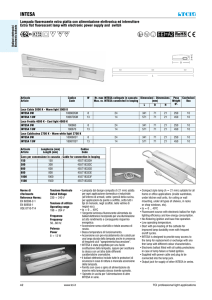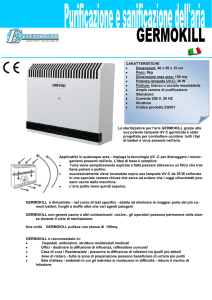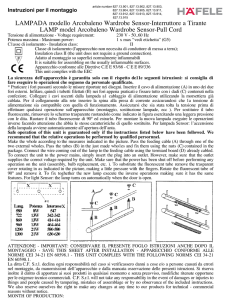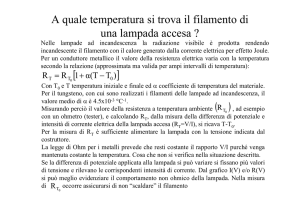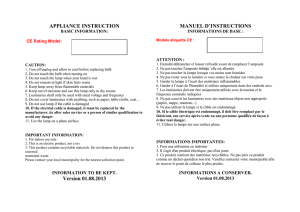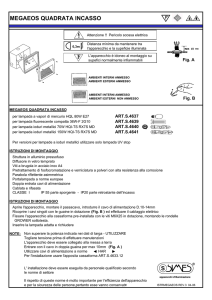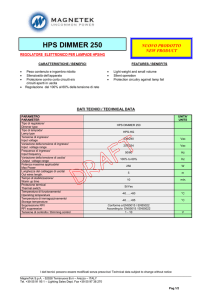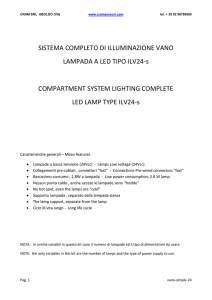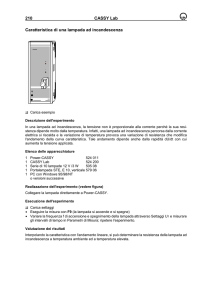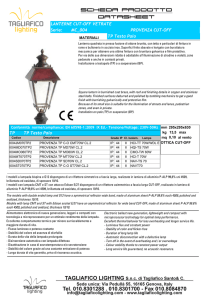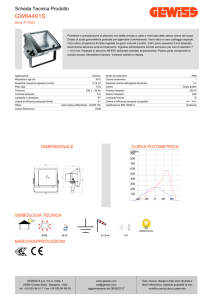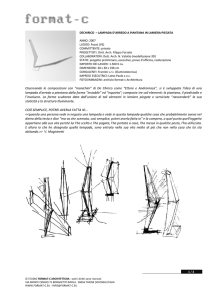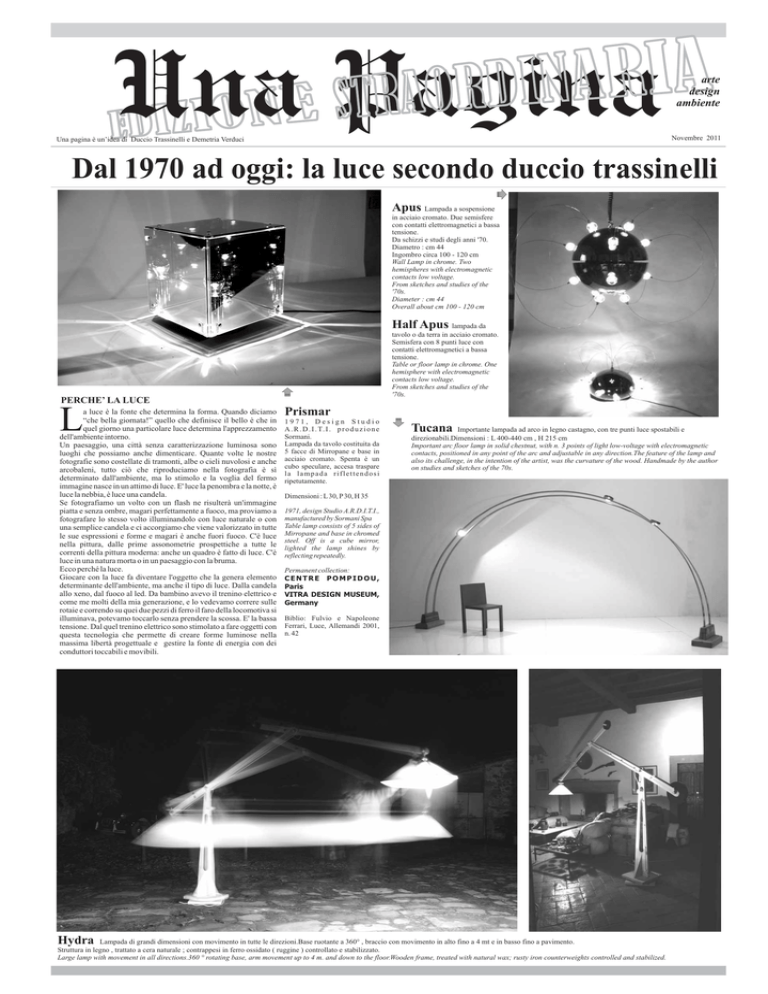
Pagina
arte
design
ambiente
Novembre 2011
Una pagina è un’idea di Duccio Trassinelli e Demetria Verduci
Dal 1970 ad oggi: la luce secondo duccio trassinelli
Apus
Lampada a sospensione
in acciaio cromato. Due semisfere
con contatti elettromagnetici a bassa
tensione.
Da schizzi e studi degli anni '70.
Diametro : cm 44
Ingombro circa 100 - 120 cm
Wall Lamp in chrome. Two
hemispheres with electromagnetic
contacts low voltage.
From sketches and studies of the
'70s.
Diameter : cm 44
Overall about cm 100 - 120 cm
Half Apus
lampada da
tavolo o da terra in acciaio cromato.
Semisfera con 8 punti luce con
contatti elettromagnetici a bassa
tensione.
Table or floor lamp in chrome. One
hemisphere with electromagnetic
contacts low voltage.
From sketches and studies of the
'70s.
PERCHE’ LA LUCE
L
a luce è la fonte che determina la forma. Quando diciamo
“che bella giornata!” quello che definisce il bello è che in
quel giorno una particolare luce determina l'apprezzamento
dell'ambiente intorno.
Un paesaggio, una città senza caratterizzazione luminosa sono
luoghi che possiamo anche dimenticare. Quante volte le nostre
fotografie sono costellate di tramonti, albe o cieli nuvolosi e anche
arcobaleni, tutto ciò che riproduciamo nella fotografia è sì
determinato dall'ambiente, ma lo stimolo e la voglia del fermo
immagine nasce in un attimo di luce. E' luce la penombra e la notte, è
luce la nebbia, è luce una candela.
Se fotografiamo un volto con un flash ne risulterà un'immagine
piatta e senza ombre, magari perfettamente a fuoco, ma proviamo a
fotografare lo stesso volto illuminandolo con luce naturale o con
una semplice candela e ci accorgiamo che viene valorizzato in tutte
le sue espressioni e forme e magari è anche fuori fuoco. C'è luce
nella pittura, dalle prime assonometrie prospettiche a tutte le
correnti della pittura moderna: anche un quadro è fatto di luce. C'è
luce in una natura morta o in un paesaggio con la bruma.
Ecco perché la luce.
Giocare con la luce fa diventare l'oggetto che la genera elemento
determinante dell'ambiente, ma anche il tipo di luce. Dalla candela
allo xeno, dal fuoco al led. Da bambino avevo il trenino elettrico e
come me molti della mia generazione, e lo vedevamo correre sulle
rotaie e correndo su quei due pezzi di ferro il faro della locomotiva si
illuminava, potevamo toccarlo senza prendere la scossa. E' la bassa
tensione. Dal quel trenino elettrico sono stimolato a fare oggetti con
questa tecnologia che permette di creare forme luminose nella
massima libertà progettuale e gestire la fonte di energia con dei
conduttori toccabili e movibili.
Hydra
Prismar
1971, Design Studio
A . R . D . I . T. I . p r o d u z i o n e
Sormani.
Lampada da tavolo costituita da
5 facce di Mirropane e base in
acciaio cromato. Spenta è un
cubo speculare, accesa traspare
la lampada riflettendosi
ripetutamente.
Tucana
Importante lampada ad arco in legno castagno, con tre punti luce spostabili e
direzionabili.Dimensioni : L 400-440 cm , H 215 cm
Important arc floor lamp in solid chestnut, with n. 3 points of light low-voltage with electromagnetic
contacts, positioned in any point of the arc and adjustable in any direction.The feature of the lamp and
also its challenge, in the intention of the artist, was the curvature of the wood. Handmade by the author
on studies and sketches of the 70s.
Dimensioni : L 30, P 30, H 35
1971, design Studio A.R.D.I.T.I.,
manufactured by Sormani Spa
Table lamp consists of 5 sides of
Mirropane and base in chromed
steel. Off is a cube mirror,
lighted the lamp shines by
reflecting repeatedly.
Permanent collection:
CENTRE POMPIDOU,
Paris
VITRA DESIGN MUSEUM,
Germany
Biblio: Fulvio e Napoleone
Ferrari, Luce, Allemandi 2001,
n. 42
Lampada di grandi dimensioni con movimento in tutte le direzioni.Base ruotante a 360° , braccio con movimento in alto fino a 4 mt e in basso fino a pavimento.
Struttura in legno , trattato a cera naturale ; contrappesi in ferro ossidato ( ruggine ) controllato e stabilizzato.
Large lamp with movement in all directions.360 ° rotating base, arm movement up to 4 m. and down to the floor.Wooden frame, treated with natural wax; rusty iron counterweights controlled and stabilized.
Una Pagina
EDIZIONE STRAORDINARIA
Novembre 2011
FACCIA AFACCIAcon Duccio Trassinelli
5 domande di Demetria Verduci
DV: Curiosamente, mentre siamo abituati a considerare Milano la città del
design, viene spesso taciuto il ruolo che Firenze ha esercitato in modo
diretto ed indiretto nell'evoluzione dell'industrial design.
Nel capoluogo toscano, nella metà degli anni '50 nasce, curato da Pierluigi
Spadolini, il primo corso a livello universitario di design con la dizione
Progettazione Artistica per l'Industria; nel 1962 è istituito l'Isia (Istituto
Superiore per le Industrie Artistiche), con docenti dello spessore e
competenza dello stesso Spadolini, Giovanni Klaus Koenig e Leonardo
Benevolo.
Tu hai incominciato a lavorare per aziende come Cassina, Flos, Sormani ,
prima ancora di terminare gli studi all'ISIA, come ti ha influenzato
quell'ambiente?
DT: L'ISIA ha influito indubbiamente in modo molto positivo data anche
l'alta qualità dei docenti, ricordo anche Pierangelo Cetica e Ugo Saccardi .
Gli stimoli primari erano di carattere culturale , dopo aver acquisito gli
strumenti di base l'analisi era fondata su alcune finalità fondamentali : creare
nuovi oggetti per uso quotidiano e non, sfruttando al massimo la creatività
che le nuove tecnologie permettevano. Indubbiamente il corso di studi e
l'ambiente mi hanno stimolato in ciò , oltre ad altre esperienze esterne di
curiosità personale per la meccanica, principi di fisica elementare e per tutto
ciò che apparentemente funzionava in modo strano. Gli studi e l'età hanno
fatto il resto.
DV: La tua produzione è molto eterogenea: qual è il metodo progettuale che
ti permette di affrontare tipologie tanto diverse, come esempio un tappo per
tetrapak e una lampada da tavolo?
DT: Concentrazione, concentrazione sul problema acquisendo tutti i dati
informativi del settore a cui compete l'oggetto progettato.
Tempo, riflessioni, analisi funzionali e tecnologiche pensando sempre
all'uomo come fruitore ed osservatore dell'oggetto che vai a progettare.
Ricerca di tecnologie nuove e soluzioni alternative avvicinandosi a materiali
magari fino ad allora non utilizzati.
DV: Il design-art, i pezzi unici e semiartigianali, a metà strada fra arte e
design, sembrano essere la nuova tendenza del settore. Tu cosa ne pensi? E'
una contaminazione lecita?
DT: E' una contaminazione giusta, fortemente giusta per rivalutare il design,
per recuperare quello che nel '68 criticavamo nel manifesto, per far sì che un
progetto parta da stimoli intellettuali e funzionali non dettati da precisa
committenza. Elevare il ruolo del design a livello di spinta per la produzione
che non sempre vede le finalità di migliorare l'oggetto e il suo uso, ma solo di
fare profitti su di esso. Questo nuovo ruolo del design potrà ulteriormente
svilupparsi creando un mercato di piccole serie che potrà far capire meglio la
libertà intellettuale e politica della filosofia dell'oggetto.
Duccio with goose ©Yola Monakhov
Yola Monakhov vive a New York. Insegna
fotografia alla Columbia University ed è
fotografa per la rivista New Yorker. Ha fatto
reportage in Kosovo, Iran, Afghanistan,
Medio Oriente e ex Unione Sovietica.
Yola Monakhov lives in New York. Currently
she teaches photography at Columbia
University and is contributing photographer
for the New Yorker magazine. As a
photojournalist, she photographed in
Kosovo, Iran, Afghanistan, the Middle East
and the former Soviet Union.
DV: Poi, dopo la laurea, pur continuando a svolgere la professione hai
insegnato per dieci anni Metodologia della Progettazione proprio all'ISIA
di Firenze, e poi hai dato le dimissioni , cosa non ti convinceva più ?
DT: Ah! questo fu proprio una sorpresa, visto che avevo cercato di imparare
a fare lo studente e di imparare una professione , trovarmi di fronte a coetanei
e dover trasmettere le mie informazioni nel ruolo di docente fu veramente
emozionante e scioccante. Negli anni in cui ero studente avevamo cercato di
modificare parte della struttura didattica che non ci convinceva pienamente,
siamo negli anni del '68. Una volta cambiato il ruolo fui sorpreso , ma anche
contento di poter divenire attore e stimolatore dei cambiamenti che
chiedevano gli studenti, ma dopo anni di tentativi mi accorsi che alcune
forze interne conservatrici non permettevano questo radicale cambiamento,
cambiamento con cui chiedevo che la scuola, pur continuando la
sperimentazione, si avvicinasse maggiormente al mondo reale con le sue
problematiche tecniche , di produttività economica e marketing , senza
perdere le finalità originali ideate da Pierluigi Spadolini.
DV: Nel 1970 quando hai fondato lo STUDIO A.R.D.I.T.I. , con gli altri
componenti del gruppo, avete adottato come proclama un manifesto
realizzato da voi studenti, cosa volevate dire con quel manifesto?
DT: Questo manifesto nasce nel 1968 da un gruppo di studenti del Corso
Superiore di Disegno Industriale di Firenze.
1968: anni della contestazione, del capitalismo, del consumismo, delle
guerre, delle baronie universitarie , dei beni di consumo indotti ; gli studenti
di quegli anni si ponevano delle problematiche, tra cui l'essere addestrati per
la società, ma quale società?
Ci avevano detto che il ruolo del designer era quello di razionalizzare ed
utilizzare i metodi di produzione per migliorare, tramite gli oggetti d'uso, le
condizioni della vita abbassando i costi.
Ma ci rendevamo conto che per il sistema intero non era così, in realtà tutto
assomigliava più a Re Mida che intendeva trasformare tutto in oro fino a
diventare vittima della propria cupidigia.
Coscienti di ciò, quegli studenti tra cui il sottoscritto, vollero rendere noto
con questo manifesto, attraverso giochi dialettici, critici e sarcastici, la loro
presa di coscienza.
Questo non significa rinunciare all'apprendimento, ma cercare di utilizzare i
propri studi su canoni più concreti e razionali.
Ecco quindi il proclama dove ci attribuiamo il ruolo di massima
responsabilità nei confronti della società tutta, parafrasando e elencando
oggetti dei “mostri sacri” del design , senza citarne il nome, ma descrivendo
quegli oggetti e mischiandoli alle contraddizioni del sistema: dai “berretti
verdi” a prodotti assurdi come le “macchine acchiappa-lucciole “ ,
“macchine strappa lingue” , “ assorbenti igienici per galline”, e così via.
Questa denuncia , non un rifiuto, non è altro che un proclama di ingenua
onestà del nostro gruppo di studenti. Ingenui, ma oggi cosa accade?
Oggi il sistema si contorce su se stesso con gli stessi elementi di 40 anni fa,
ma con la fondamentale diversità che negli anni '70 riassorbiva tutto grazie
al boom economico, adesso il sistema non sostiene più se stesso ed è per
questo che il proclama degli studenti del '68 rende particolarmente odierno il
sarcasmo di quel manifesto.
IAttualmente abbiamo il non-denaro ( carte di credito, fidi, ecc ) usato per il
consumismo che è in uno stadio di saturazione assoluta e dimostra che il
mercato ha necessità di beni reali e non fittizi.
Il consumo deve essere collegato alla creatività ed alla produttività
dell'uomo.
B.T.2
Design : STUDIO A.R.D.I.T.I. 1971, prodotta da Sormani Spa
Patent : Duccio Trassinelli n. 157419 , 27/6/1973
Lampada da tavolo. Acciaio cromato, bassa tensione, con contatti
elettromagnetici posizionabili in ogni punto.
Chromed steel table lamp, low voltage with lighting electromagnetic
elements positioned at any point.
Rete
prototipo, pezzo unico
Lampada terra/soffitto con dischi in metallo e rete tubolare
Prototype, unique piece
Floor/Ceiling lamp. Net and metallic part.
Permanent collection : MoMA, New York; Centre
Pompidou, Paris
Exhibition : Eurodomus 1972
Biblio: F.& N. Ferrari “Luce-Lampade 1968-1973 : il nuovo design
italiano” Edizione Allemandi, Milano 2002
“1000 Lights” , Charlotte e Peter Fiell, Edizione Taschen
Catalogue de l'exposition "Lumières, je pense à vous" du Centre de
Création Industrielle du 3 juin au 5 août 1985 - Editions du Centre
Pompidou et Editions Hermé - Paris 1985.
Lyra
lampada da tavolo. Base piramide in acciaio sulla quale sono
posizionate , tramite magneti, quattro sorgenti di luce a bassa tensione.
Lyra, lampada da terra con base in marmo di Carrara , piramide in acciaio
con otto sorgenti di luce.
Lyra da soffitto, piramide in acciaio, otto punti luce a bassa tensione.
Lyra
table lamp with base in steel, pyramid on which are attached via
magnets, four balls light sources.
Lyra floor lamp with base in Carrara marble, steel pyramid with eight
light sources.
Lyra wall lamp, steel pyramid , eight light sources low- voltage
Una Pagina
arte_design_ambiente
online su : www.chianticom.com
Stampa : Tipografia Grevigiana
Una Pagina
Perché ?
EDIZIONE STRAORDINARIA
Novembre 2011
Questa edizione straordinaria di Una Pagina rappresenta in
parte la ricerca fatta negli anni da Duccio Trassinelli nel
design illuminotecnico, ambito in cui è stato tra i primi a
sperimentare la bassa tensione. Oggetti illuminanti in cui i
materiali, acciaio, legno, marmo, carbonio e pietre cedono
Tristilo
Ponte
1972 prototipo Studio A.R.D.I.T.I. , realizzato con Sirrah.
Lampada da soffitto con tre bracci telescopici e un punto luce
direzionabile.
1972 prototipo Studio A.R.D.I.T.I., Made in collaboration with
Sirrah.
Ceiling lamp with three telescopic arms. One light adjustable in any
direction.
Design : STUDIO A.R.D.I.T.I.
USA Patent : Duccio Trassinelli n. 3748463
alla volontà del designer di asservirli alla funzione della
luce. Usando la tecnologia come gioco e libertà nasce la
sfida della grande curvatura del legno, come nella lampada
Tucana e per incanto o assoluto minimalismo da una pietra
esce uno stelo di luce. DV
1970, produzione Sormani
Lampada da terra , ad arco completo , regolabile in altezza e larghezza
mediante lo spostamento delle basi . Basi in marmo di Carrara steli
cromati e globi luce in Lexan . I globi-luce possono scorrere lungo
tutta la lunghezza dell'arco. Bassa tensione 12 v
Dimensioni variabili : H : 220 L: 380 P: 30 cm
1970, manufactured by Sormani
Arc floor lamp, adjustable in height and width by moving the base. Base
Carrara’s marble, chrome stems, light globes in Lexan. The light globes
can slide along the entire lenght of the arc.Low voltage 12v
Variable dimensions H:220 L:380 P:30 cm
Permanent collection MoMA, New York
Biblio: “Luci Lampade 1968-1973, Il nuovo Design Italiano” photo 102
by Fulvio and Napoleone Ferrari. Ed. Allemandi Image No 88 'Casa
Vogue', september 1973 'Domus', November 1973
Exhibited at the “Salone del Mobile” Milan 1971
Lybra
lampada da tavolo, bassa tensione, punto luce orientabile. Base
in noce. Optional touch system.
Table lamp, low voltage with light rotated in all directions.
Walnut wood base.Optional touch system.
H: 60 cm
Triangulum
Cassiopea
lampada da terra a bassa tensione, oscillante,
con punto luce orientabile. Base in noce.
lampada da tavolo, bassa tensione, punto luce
orientabile. Base in legno. Optional touch system.
Da studi e schizzi degli anni ‘70.
Table lamp, low voltage with light rotated in all directions.
Wood base.Optional touch system.
From sketches and drawings of the 70s.
Floor lamp, low voltage with adjustable light in all directions.
Base point and light walnut. Lamp flexible and oscillating.
Cassiopeia big : h 200 cm
Cassiopeia small : h 145 cm
Cygnus lampada da tavolo, base in legno. Bassa tensione.
L 100 cm , H 58 cm
Table lamp base made of cedar wood.Low voltage.
Mida
oro, carbonio, marmo
gold, carbonium, marble
LA MACINA DI SAN CRESCI
Residence for artists. Atelier.
Place for creation, hearing
and discussion, where imagine
new forms of dialogue within
the context of art and culture.
Workshop of experience
where professional and young
artists can work together.
Residenza per artisti. Atelier.
Spazio di studio, visione,
ascolto e discussione,
dove immaginare
nuove forme di
dialogo,
ricezione
e diffusione
dell’arte
e della
cultura.
Laboratorio
di esperienza
dove si
alternano e
convivono
artisti-maestri
e giovani
emergenti.
Una Pagina
arte/ art
design
ambiente/environment
pubblicazione
periodica/periodical
edita da/published by
La Macina di San Cresci
One Page
art
design
environment
November 2011
One page is an idea of Duccio Trassinelli & Demetria Verduci
From 1970 until today: the light by duccio trassinelli
WHY THE LIGHT?
L
ight is the source that determines the form. When
we say "what a beautiful day!" What defines the
“beautiful” is on that day a special light
determines the appreciation of the environment around.
A landscape, a city without light characterization are
places that we can forget. How many times our
photographs are filled with sunsets, dawns or cloudy
skies and even rainbows, everything that is reproduced in
the photograph is so determined by the environment, but
the stimulus and the desire of the still image was created
in a flash of light. Is light the darkness and the night, the
fog is light, a candle is light.mmmmmmmmmmmmm.
If you photograph a face image with a flash it will be flat
and without shadows, even in perfect focus, but we try to
photograph the same face with natural light or with a
simple candle and we realize that is valued in all its
expressions and forms, and perhaps also out of focus.
There is light in painting, from the first axonometric
perspective to all currents of modern painting: a picture
is made of light. There is light in a still life or a landscape
with the mist.mmmmmmmmmmmmmmmmmmmmm.
That's why the light.mmmmmmmmmmmmmmmmmm.
Playing with light makes the object that generates the key
element of the environment, but also the type of light.
Xenon from the candle, led to the fire. As a child I had the
electric train and like me many of my generation, and we
saw it running on the rails and running on those two
pieces of iron the headlight of the locomotive was lit, we
could touch it without getting an electric shock. It is the
low voltage. By electric train I am stimulated to do
objects with this technology that allows to create shapes
in maximum freedom and manage the energy source
with wires and moveable touchable.
Aries
B.T.1 Design Studio A.R.D.I.T.I. manufactured by Sormani Spa , 1971. Wall lamp in stainless steel
carbon, n. 6 light point, low voltage with magnetic contacts positioned at any point of the panel.
Lampada da muro in acciaio con 6 punti luce posizionabili . Bassa tensione, contatti elettromagnetici.
Design Studio A.R.D.I.T.I. 1971, prodotto da Sormani Spa. 90 x 90 cm
FENICE 2
Table lamp with marble base and
electromagnetic contacts.
Lampada da tavolo con base in
marmo e contatti
elettromagnetici.
12 x 12 cm base, H cm 70
B.T. Promozionale
NEWS OF THE MONTH
Design Studio A.R.D.I.T.I.
1971, table lamp manufactured by
Sormani Spa, made as promotional
object.
Patent : Duccio Trassinelli n. 157419
,27/6/1973
Chromed steel table lamp, low voltage
with
lighting electromagnetic
elements positioned at any point.
Design Studio A.R.D.I.T.I. 1971,
Lampada da tavolo produzione
Sormani, realizzata come oggetto
promozionale.
Dimensioni base cm 13x13 , H cm 60
La lampada
è composta da un
triangolo in legno con piastre
d'acciaio sulle quali sono attaccati,
tramite magneti , i cilindri plastici
sorgenti di luce. Un trasformatore
trasmette corrente a bassa tensione
12v a tutto l'involucro esterno della
scatola e l'altra polarità alla piastra
attraverso i magneti. I punti luce
possono essere spostati in qualunque
punto delle superfici.
MIDA
Table lamp with base in Carrara’s marble, carbonium and gold foil,
n. 6 lighting adjustable.
Lampada da tavolo con base in marmo di Carrara, carbonio e
foglia d’oro. Bassa tensione, n.6 punti luce posizionabili .
One Page
SPECIAL EDITION
November 2011
Face to face with Duccio Trassinelli
5 questions of Demetria Verduci
DV:Curiously, while we are accustomed to regard Milan as the city of
design, it is often disregarded that Florence has exercised directly and
i n d i re c t l y i n t h e d e v e l o p m e n t o f i n d u s t r i a l d e s i g n .
In the mid-'50s in Florence , the first course of design at university level
began , called Artistic Design for the Industry, founded by Pierluigi
Spadolini ; in 1962 it established the ISIA (Upper Institute for Artistic
Industries) with teachers like Spadolini, Giovanni Klaus Koenig and
Leonardo Benevolo.MMMMMMMMMMMMMMMMMMMMM.
You started to work for companies such as Cassina, Flos, Sormani,
before ending your studies to ISIA. How has that environment
influenced you?MMMMMMMMMMMMMMMMMMMMMMM?
DT:Undoubtedly the ISIA has influenced me in a very positive way ,
because the high quality of teachers. For example, I remember
Pierangelo Cetica and Ugo Saccardi.
The primary incentives were of cultural nature, then having acquired the
basic tools, the analysis was based on some fundamental purpose: to
create new objects for daily use and not , making the most creativity that
new technologies allow.
Undoubtedly, the studies and the environment have encouraged me in
this, as well as other experiences outside like personal curiosity for the
mechanics, the principles of basic physics and all that apparently worked
so strange. Studies and age did the rest.MMMMMMMMMMMMM.
DV: The design-art objects unique and almost handmade , halfway
between art and design, appear to be the new trend in the industry. What do
you think? It is a good direction?MMMMMMMMMMMMMMMM?
DT: It is a good direction, strong enough to re-evaluate the design, to
recover what we criticized in 1968 with our manifesto, and to ensure that a
project starts by an intellectual stimulation and not dictated only by
commissioning.
Elevate the role of design by supporting its purpose of improving the object
and its use, not only to make profit.
This new role of design will further expand by creating a market of a small
number of products that will consider the intellectual freedom and political
philosophy of the object.
Leo
Table lamp. Base in stone. Each piece is unique.
Optional Touch System: Regulate by touching the sensorial part of the lamp. To
switch on and off, touch briefly the sensorial part/push-button of the lamp. To
regulate light intensisty, keep contact with sensorial part/push button of the lamp
until the desired level is reached, interrupt the contact once this light level is
reached. Once switched off, the light level is memorized and lamp will switch on
again at the same level. Keeping the contact will the sensorial part/push-button of
the lamp for longer while switching on will allow to reach the maximum light level.
Lampada da tavolo con base in pietra. Ogni pezzo è unico.
Cm 70 x 25, H 70 cm
Ara
Floor lamp. Flexible idraulic tube and stones with gold foil
Lampada da terra , tubo idraulico flessibile e pietre rivestite in foglia
d’oro.
Cm 50 x 50, H 70 cm circa/about
Indus
DV : In 1970 when you founded the STUDIO A.R.D.I.T.I. , your group
have adopted a manifesto realized by you students. What means this
manifesto?
DT: This manifesto was produced by a group of students studying
Advanced Industrial Design in Florence, Italy, in 1968.
1968: the years of protest: against capitalism, against consumerism,
against war, against university administrators, against built-in
obsolescence; The students of those years asked many questions and
specifically, for what society were they being trained for?
They had told us that the role of the industrial designer was to use
common logic and production methods to lower the cost of everyday
objects and thereby increase the standard of living for all. We realized
however, that the over-all system did not function in this manner, that in
fact, everything appeared to be similar to the world of King Midas who
desired to turn everything into gold until nothing had value. Aware of this
those students, myself included, wished to let their position be known
though critical and sarcastic word play which is declared in this
manifesto. This does not entail renouncing the learning process, but
rather, to use one's time at school to follow more rational and straight
forward ideological constructs.
Here therefore is the manifesto where we proclaim, as responsible
leaders of all society, our ideas. With innuendo we list, in an indirect
manner, the important markers of industrial design, without specific
reference, but through description we mix them into the contradictions of
the system; From objects such as the green berets to absurd products like
the firefly catcher and the tongue ripping machine to absorbent napkins
for chickens and etc.
This proclamation is not a refutation of the system but rather an honest
declaration made by an innocent group of students, and yet, maybe not so
innocent. Consider the situation today? The system today is wrapped
around itself with the same elements as 40 years ago, but with a
fundamental difference compared to the 1970s where the economic
boom was able to cushion and absorb excess production. Today the
system is no longer sustainable and so the sarcastic tone of the student
proclamation from 1968 is particularly relevant. In the present we have
non-currency (credit cards, bank over-drafts and etc.) used for the
consumer experience which is in a state of absolute saturation and shows
that the market requires real goods and not fictional ones. Consumerism
must be connected to the productivity and creativity of man.
DV: Your production is very heterogeneous: what is the design method
that allows you to deal with different typologies, such as a bottle-cap
and a table lamp?MMMMMMMMMMMMMMMMMMMMMM?
DT: Concentration, concentration on the problem and acquiring all the
information about the planned object.MMMMMMMMMMMM.
Time, reflections, functional and technological analysis, always
focusing on the individual like a user and an observer of the object.
Search for new technologies and alternative materials maybe
approaching another possibility.
Floor lamp with base in Carrara marble.
No 8 Low-voltage lights can be positioned anywhere
Lampada da terra con base in marmo di Carrara. 8 punti luce con
contatti elettromagnetici.
Size: base cm 30x30 h cm 170
Serpens
Ara
Prototypes/prototipi
Cm 70 x 70, H cm 200 circa/about
Floor lamp with base in stone. Wood articulated joints.
Lampada da terra con base in pietra. Snodi in legno.
Cm 50 x 25, H cm 100 circa/ about
One Page
Why ?
SPECIAL EDITION
November 2011
This special edition of One Page partially represents the
research done over the years by Duccio Trassinelli in
lighting design, an area in which he was among the first to
experience the low voltage. Lighting Objects in which the
materials, steel, wood, marble, carbon and stone yield
to the will of the designer to enslave them to the function
of the light. Using the technology as a game and freedom,
comes the challenge of greater curvature of the wood, as
in the lamp Tucana, and by magic or absolute minimalism
from a stone goes out a stem of light. DV
Perseus
Ceiling lamp. Linear chestnut-wood frame. Three magnetic lighting
adjustable in every direction
Adjustable height, L cm 200
Lampada da soffitto. Barra in legno. Tre punti luce in legno con contatti
elettromagnetici, posizionali in ogni punto e orientabili.
Altezza regolabile, L cm 200
Scorpius
Panel lighting in stainless steel, with a central band in wood. N. 1 light
point, low voltage with electromagnetic contacts. Cm 53 x 53
Pannello luminoso in acciaio con fascia centrale in legno. Bassa tensione,
un punto luce spostabile e direzionabile.
B.T.Pyramid
C e t u s F l o o r l a m p , l o w Pavone Table lamp, wood and
voltage,contacts electromagnetic . cotton. H 76
Chestnut wood with two lights placed Lampada da tavolo in legno e
on each point arc and oriented in any cotone. H 76 cm
direction. H 200 cm
Wall lamp, prototype 1972. The lamp is made of
stainless steel plate on which are attached via magnets, plastic cylinders of
light sources. A transformer transmits low voltage 12v all the exterior of the
box and the other polarity to the plate through the magnets. The lights can be
moved anywhere on the surface. Cm 90 x 90
Lampada da muro, prototipo 1972.
La lampada è composta da piastre in acciaio inossidabile sulle quali sono
attaccati, tramite magneti , i cilindri plastici sorgenti di luce. Un
trasformatore trasmette corrente a bassa tensione 12v a tutto l'involucro
esterno della scatola e l'altra polarità alla piastra attraverso i magneti.
I punti luce possono essere spostati in qualunque punto delle superfici.
Lampada ad arco in legno. Due
punti luce spostabili.Bassa
tensione, contatti elettromagnetici.
Norma
Wall/ceiling lamp. Wood, two magnetic lighting
adjustable in any direction. L 2,25 cm
Lampada da muro o soffitto. In legno, due punti luce magnetici,
orientabili in ogni direzione. L 2,25 cm
Taurus Panel lighting in
stainless steel carbon, with a central
band in solid chestnut made from a
barrel of 1700s. With
electromagnetic contacts, low
voltage.
Pannello in acciaio con fascia
centrale in legno massello ricavata
da una botte del ‘700. Contatti
elettromagnetici, bassa tensione.
Size 115x115 cm, 5 cm thick.
Fenice

